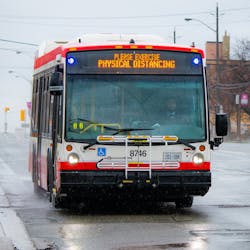Toronto accelerates priority bus-only lanes; starts with Eglinton East corridor
Six corridors will be evaluated for priority bus-only lanes in Toronto, Ontario, Canada with the city’s Eglinton East corridor identified as the top priority.
Five of the proposed priority bus-only lanes were included in the Toronto Transit Commission’s (TTC) 5-Year Service Plan & 10-Year Outlook, which was released in December 2019. They included Jane Street from Eglinton Avenue to Steeles Avenue; Dufferin Street from Dufferin Gate to Wilson Avenue; Steeles Avenue West from Yonge Street to Pioneer Village Subway Station; Finch Avenue East from Yonge Street to McCowan Road and Eglinton Avenue East/Kingston Road/Morningside Avenue from Kennedy Subway Station to the University of Toronto, Scarborough. A sixth corridor, Lawrence East (East of Victoria Park to Rouge Hills Drive) was later added.
The five original corridors above had a combined, pre-COVID-19 ridership of approximately 220,00 passengers per weekday. TTC says the Eglinton East bus corridor is among its most heavily used and, even during COVID-19, continues to play a significant role in moving people around the city.
“The TTC is the primary means of travel for many people in Toronto. The transit system has a critical role to play in the economic restart and recovery of the city. Bus trips represent the largest total vehicle mode both before COVID-19 and throughout the pandemic,” said TTC CEO Rick Leary. “Bus priority lanes are an important step in keeping the TTC ahead of the ridership curve and are an immediate benefit to our customers. Accelerating the implementation of bus priority lanes is one way to ensure that our riders can reach their destinations in a safer and more timely manner.”
The proposed timing and priority of the bus-only lanes is as follows:
- Priority A: Eglinton East
- July to October 2020: evaluation, design, data collection
- Fall 2020: Implementation, monitoring and reporting
- Priority B: Jane Street
- July 2020 to spring 2021: evaluation, design, data collection
- Spring 2021: Implementation, monitoring and reporting
- Priority C: Steeles Avenue West, Finch Avenue East, Dufferin Street, Lawrence Avenue East
- Timing to be determined
The 8.5-kilometer (5.3-mile) Eglinton East corridor became the top candidate for the accelerated installation of priority bus lanes based on an assessment of a number of factors, including improvement to transit reliability, available right-of-way, considerations for transportation equity and it serves seven of Scarborough’s eight Neighborhood Improvement Areas. TTC says the High Occupancy Vehicle lanes on Eglinton Avenue East would be converted to priority bus-only lanes, while curbside general-purpose lanes on Kingston Road and Morningside Avenue would be converted to priority bus-only lanes. The priority bus lanes would be reserved for bus-only use 24 hours a day, seven days a week, would be identified using red surface treatment and signage and would have a one-time installation cost of approximately C$7.8 million (US$5.77 million).
“As Toronto re-opens and recovery begins, the TTC’s surface transit network will play a critical role in getting people around the city,” said Toronto Mayor John Tory. “Expediting the priority bus-only lanes along the Eglinton corridor will help move people across Scarborough quickly, safely and reliably so that they can spend less time commuting. Enhancing service will also ensure the TTC continues to be an attractive mobility option for residents, helping us reduce congestion and the environmental impacts associated with dependence on the car.”
The proposed priority bus-only lane on the Eglinton East corridor is anticipated to reduce transit travel time on average between two to five minutes per trip. The time savings achieved equate to annual savings of C$2.5 million (US$1.85 million) in operating costs and a one-time capital cost savings of approximately C$6.3 million (US$4.66 million), as a result of fewer buses required to provide the same level of service on the corridor. These cost savings could allow the TTC to reinvest in other transit opportunities in this corridor, as demand increases or in other areas of the city where there is crowding.
About the Author

Mischa Wanek-Libman
Group Editorial Director
Mischa Wanek-Libman is director of communications with Transdev North America. She has more than 20 years of experience working in the transportation industry covering construction projects, engineering challenges, transit and rail operations and best practices.
Wanek-Libman has held top editorial positions at freight rail and public transportation business-to-business publications including as editor-in-chief and editorial director of Mass Transit from 2018-2024. She has been recognized for editorial excellence through her individual work, as well as for collaborative content.
She is an active member of the American Public Transportation Association's Marketing and Communications Committee and served 14 years as a Board Observer on the National Railroad Construction and Maintenance Association (NRC) Board of Directors.
She is a graduate of Drake University in Des Moines, Iowa, where she earned a Bachelor of Arts degree in Journalism and Mass Communication.
